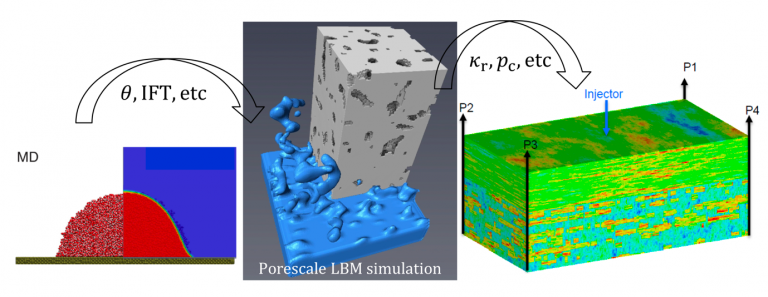In the study of rock characterization, absolute/relative permeability and endpoint saturations are the most important properties and commonly used to evaluate the reservoir quality and predict the production performance. Although the experimental technology for direct measurement is well established, it becomes time-consuming for rock sample of very low permeability and might be subject to error due to the high capillary number effect when using injecting speed much higher than the in-situ one or the undesired Klinkenberg slippage effect when using gas media as substitute to speed up the flow penetration process. Additionally, experimental tests are also costly, sometimes destructive to the rock samples, and available in a limited range of confining pressure, pore pressure and temperature.
The pore-scale simulation based on the lattice Boltzmann method is a well-developed technology to mimic the core flooding process and predict the properties for rock characterization. Prior to the simulation, the high-resolution scanning and segmentation technology will be used to acquire the digitalized rock sample of high fidelity (without simplification to pore network model), based on which the pore-scale simulation is carried out. This simulation study complements and significantly expands the potential of the fancy rock imaging facility and now becomes an alternative to the conventional core flooding experiment. Additionally, the simulation study can predict the recovery performance of modifying the interfacial properties as in the chemical EOR, which also provides the optimal range of wettability and IFT as the design guidance of synthesizing surfactant. The correlation between simulations at different scales is illustrated in the following figure.

The study of pore-scale simulations at CPG covers both basic research and real applications in the area of petroleum engineering. These include the fundamental study of movement of contact line and dynamic contact angle in capillary tube, recovery mechanism in microfluidics, and predictions of relative permeability and endpoint saturations for real rock characterization. With the help of advanced HPC, our technology Gigapores can handle the simulation of digital rock with a billion voxels.


Dr. Jun Li, Research Engineer at the Center for Integrative Petroleum Research (CIPR), have independently developed this technology over many years. He conducted several validations in both benchmark cases and real problems. His results agree well with experimental measurements and predictions by available commercial software. More details about the technology are available in his book, which introduced the lattice Boltzmann method (LBM) together with the direct simulation Monte Carlo (DSMC) method, direct simulation BGK (DSBGK) method and discrete velocity method (DVM) to show their differences in spirit and correlation in theory.
References:
- Jun Li, Multiscale and Multiphysics Flow Simulations of Using the Boltzmann Equation, Springer, 2020.
